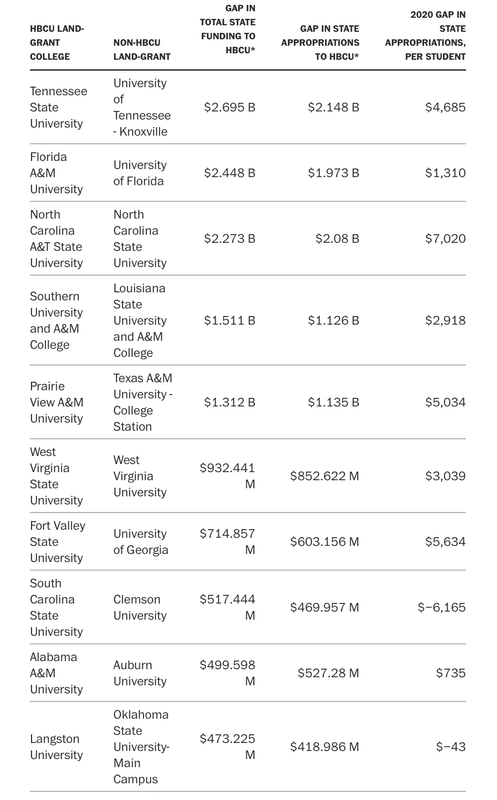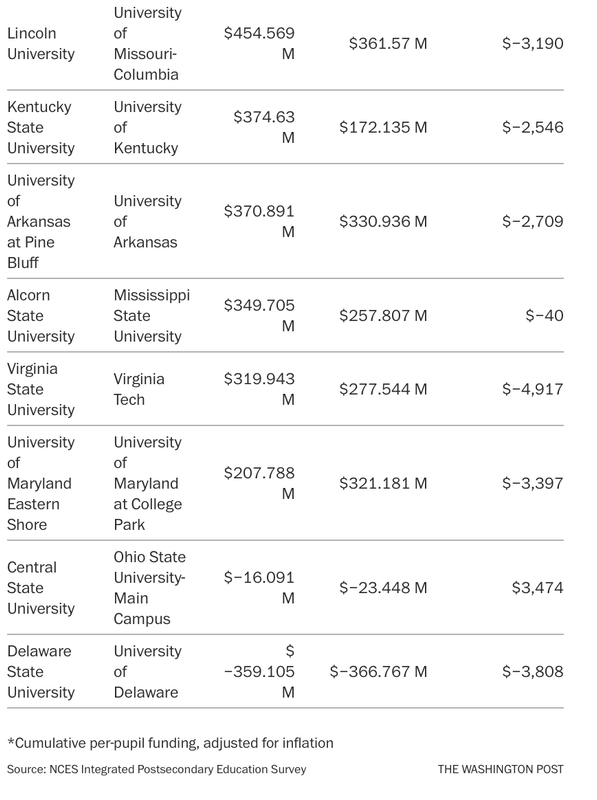States should fix underfunding of land-grant HBCUs, Biden administration says
Analysis shows inequitable appropriations to historically Black land-grant universities ranging from $172 million to $2.1 billion in recent decades
Danielle Douglas-Gabriel
A federal analysis shows historically Black land-grant universities have been underfunded by states. (Astrid Riecken for The Washington Post)
A federal analysis shows historically Black land-grant universities have been underfunded by states. (Astrid Riecken for The Washington Post)
The secretaries of education and agriculture on Monday sent joint letters to the governors of 16 states, urging them to rectify decades of underfunding to historically Black land-grant universities as a new analysis shows the colleges have collectively received some $12.6 billion less than they should have.
“Unacceptable funding inequities have forced many of our nation’s distinguished historically Black colleges and universities to operate with inadequate resources and delay critical investments in everything from campus infrastructure to research and development to student support services,” Education Secretary Miguel Cardona said in a statement Monday. “To compete in the 21st century we need state leaders to step up and live up to their legally required obligations to our historically Black land-grant institutions.”
The letters, signed by Cardona and Agriculture Secretary Thomas Vilsack, were sent to the governors of Alabama, Arkansas, Florida, Georgia, Kentucky, Louisiana, Maryland, Mississippi, Missouri, North Carolina, Oklahoma, South Carolina, Tennessee, Texas, Virginia and West Virginia. The move comes as advocates for historically Black colleges and universities have for years pushed states to increase funding for the institutions, sometimes going to court for relief.
The nation’s land-grant universities are the backbone of public higher education, a collection of schools founded in the 19th century on federal land to further agricultural instruction and research. They include Big Ten institutions and other flagship universities that have benefited from state and federal investment. States are obligated under federal law to provide an equitable distribution of state funding for all land-grant universities, but many have shortchanged the historically Black ones. And advocates for HBCUs say the federal government has looked the other way for too long.
Using data from the National Center for Education Statistics, the education and agriculture departments found a roughly $12.6 billion aggregate disparity between the funding states provided historically Black land grants and their traditionally White counterparts between 1987 and 2020. The analysis largely mirrors a 2022 accounting in Forbes magazine of the chronic underfunding of public HBCUs, but the departments’ figures are higher because they include state appropriations and contracts.
Gaps in funding to HBCU land-grant institutions
Federal law requires states to provide equivalent funding to land-grant institutions, but Black schools received less than their predominately White counterparts between 1987 and 2020.


Of the 18 states that house Black land grants — known as 1890 institutions because they were created by the Morrill Act of 1890 — only Delaware and Ohio have provided equitable funding, according to the federal analysis. Other states have instead poured resources into the traditionally White land grants that were created by the Morrill Act of 1862.
Story continues below advertisement
Tennessee and North Carolina account for the starkest disparities, as Tennessee State and North Carolina A&T universities have each received some $2 billion less than they should have over the 33-year period, the analysis shows. Florida is not far behind, with a $1.9 billion gap in total state appropriations per student between its Black land grant Florida A&M University and the University of Florida, according to the federal analysis.
The analysis captures a sliver of state underfunding because 1987 is the earliest year for which comprehensive data is available, but the decades of disparities have been well-documented. The inequities have led to lawsuits in Maryland, Mississippi, Alabama and South Carolina. Settlements in some of those cases and efforts in state legislatures to reverse funding gaps have improved the situation for some schools.
In 2020, Maryland provided its Black land grant for the University of Maryland Eastern Shore at $3,397 more per student than the University of Maryland College Park, according to the federal analysis. The state has upped its appropriations over the years, and in 2021 agreed to pay $577 million over a decade to its four HBCUs to settle a 15-year court battle over inequitable funding.
[ ‘We’re still behind’: Public HBCUs see record investments, but still contend with legacy of state-sponsored discrimination ]
The settlement and increased appropriations have helped Eastern Shore expand agricultural programs and fund scholarships. But higher education experts say the money is not enough to undo generations of state neglect. In the last 30 years alone, Maryland should have provided $321 million to the university to meet the match requirements, according to the federal analysis.
Story continues below advertisement
“These funds could have supported infrastructure and student services and would have better positioned the university to compete for research grants,” Cardona and Vilsack wrote in their letter to Maryland Gov. Wes Moore (D). “The University of Maryland Eastern Shore has been able to make remarkable strides and would be much stronger and better positioned to serve its students, your state, and the nation if made whole with respect to this funding gap.”
Moore’s office did not immediately respond to requests for comment.
University of Maryland Eastern Shore President Heidi M. Anderson said she does not expect the state to rectify generations of underfunding overnight but would like to see “strong, tangible progress” in that direction. With a projected budget deficit of $1.8 billion by 2028, Maryland may not be in the best position to take bigger steps toward parity. Still, Anderson remains hopeful.
Story continues below advertisement
“I want to believe that there are good intentions and a willingness to tackle this issue, despite a pessimistic outlook on state finances,” Anderson said. “All we’re asking for is equal treatment. Our students have been running a race in Lane 8 for too long, while their counterparts at the 1862 land-grant institutions have the inside track.”
Through litigation and political pressure, Black land-grant universities and their advocates are fighting for support. A group of six students at FAMU filed a class-action lawsuit against the state last year alleging decades of discriminatory underfunding of the university. The case is ongoing.
[ Florida A&M students sue state over funding, allege discrimination of HBCUs ]
In Tennessee, state Rep. Harold Love Jr., an alum of TSU, is pressing the state for the millions of dollars the university should have received. He pushed for a 2021 audit that found Tennessee shorted TSU as much as $544 million from 1957 to 2007 in land-grant funding.
Story continues below advertisement
Tennessee Gov. Bill Lee (R) said in 2022 the state would provide TSU with $250 million in funding for infrastructure projects. While Love said he is grateful for the governor’s response, he is advocating for more.
“We’re in a good spot right now for the next two years to really move in the direction of getting a good amount of equity for Tennessee State,” Love told The Washington Post. “At the end of the day, Tennessee State is a state institution. And the state must treat all of its own the same.”
In many ways, the federal government also has to atone for its role in the funding disparities between land-grant universities. A recent report from the Century Foundation detailed how Black land grants were excluded from federal formula payments for research and extension activities for 80 years, placing them at a disadvantage in creating the kind of infrastructure needed to compete for grant funding.
Story continues below advertisement
When states refuse to match the federal dollars afforded to Black land grants, the schools must seek a waiver from the agriculture department to keep their federal funding. Denise A. Smith, a fellow at the Century Foundation who wrote the recent report, argues the department should have done more over the years to pressure states to meet their obligations to all land grants. She said the agency should phase out the waiver to end the discrimination.
Mortimer H. Neufville, president and chief executive of the 1890 Universities Foundation, said the one-to-one match should be treated as “a floor, not a ceiling for ongoing funding” because many traditionally White land grants have long received much more than states were required to provide.
The joint letters from the education and agriculture secretaries arrive as Congress is in the midst of reauthorizing the Farm Bill, which provides federal resources to support land-grant universities. Advocates for 1890 institutions are pressing lawmakers to authorize more funding through the legislation, but that is a heavy lift given the budget caps imposed during the deal to raise the debt ceiling.
“We are making some progress,” Neufville said of the Farm Bill reauthorization. “It’s going to be tough during a period of time when they are talking about no new funding. But there’s always money on the table to do things. It’s a matter of choices.”
